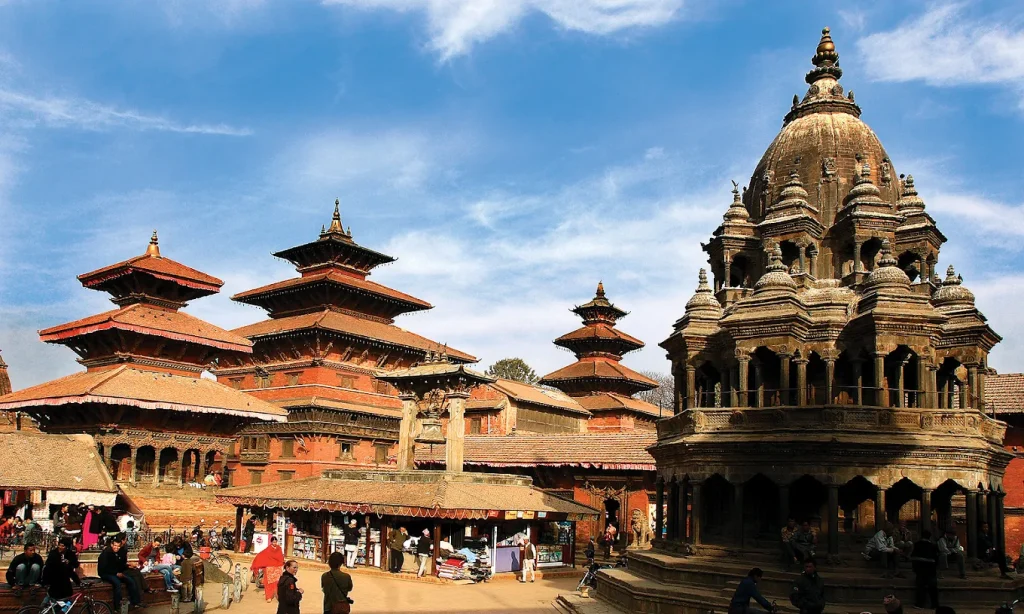
There are some places in the world that don’t just exist in space. They seem to exist outside of time. Places where the air hums with the echoes of the past, where each brick and stone has a story to tell. One such place is Patan Durbar Square, which is settle delicately in the city of Lalitpur, just a stone’s throw away from the noise and movement of Kathmandu. But the moment you step into Patan, everything slows down. The chaos melts away. And you’re somewhere else entirely. We must visiting Patan Durbar Square.
Patan is often called “The City of Fine Arts”, and when you walk through its narrow alleys, you quickly understand why. Every wall, window, and temple is a canvas of beauty, some carved in wood, some shaped in stone, and others still being created by the hands of modern artisans. The scent of incense floats through the air, bells chime softly in the distance, and the chatter of locals mixes with birdsong in the open courtyards.
Once the seat of the powerful Malla kings, Patan’s Durbar Square was more than just a palace. It was a sacred, political, and social heart of the kingdom. Today, it remains one of the most old and beautifully preserved examples of traditional Newar architecture in all of Nepal.
The first time I laid eyes on Patan Durbar Square, it felt like I had ventured onto the set of a historical epic. But, it was real. So genuine. The golden rays which is so amazing of late evening sun lit up the temples and palaces in a warm, honey-colored glow. Locals sat casually on the steps of ancient structures, chatting and watching the world go by. Children darted between stone statues. A woman offered flowers at a small shrine, her hands moving in practiced reverence.
There is something gentle and grounded about Patan. It doesn’t try to impress you with grand size or loud crowds. Instead, it invites you in, slowly, softly like an old friend.
Every step in Patan Durbar Square reveals something new. It’s not just one structure It’s an entire complex, full of temples, courtyards, and museums that invite you to pause and look closer.
This is perhaps the crown gem of the square. A 17th-century temple built from stone, shaped with an elegance that makes you stop in your tracks. The Krishna Mandir has 21 golden pinnacles and not at all like most temples in Nepal, which are built from brick and wood. On its walls are stories carved from the ancient Hindu epics, the Mahabharata and Ramayana. In the evening, devotees gather to offer prayers, their whispers blending with the soft light of butter lamps.
Housed inside the old royal palace, the Patan Museum is one of the best in South Asia. Mostly, it doesn’t feel like a typical museum. But it feels like a sacred space, full of bronze deities, antique tools, and delicate artwork that tell the story of Nepal’s spiritual and artistic soul. It’s a quiet, reflective experience and you leave feeling a little more connected to the past.
Tucked away in a side alley not far from the square is the beautiful Golden Temple a hidden Buddhist monastery shimmering with gold and devotion. Inside, monks chant softly and metal prayer wheels line the walkway. It’s a peaceful pocket of stillness, perfect for anyone seeking a moment to reflect or simply to admire the craftsmanship.
Patan Durbar Square is not just a tourist site its the pride of Nepal. It’s alive. It’s a place where people live, laugh, worship, and work. You’ll see grandmothers feeding pigeons, artists carving tiny statues with intense focus, and children playing hide-and-seek among 800-year-old walls. It feels human. It feels like home.
I spent hours just sitting on the steps of a temple, watching the sunlight change, watching life unfold. There was no rush. No pressure to “see it all.” The square encourages slowness. And somehow, you remember how to breathe deeply again and want to visiting Patan Durbar Square again and again.
Taste of Patan: Nourishment for the Body and Soul
All that strolling and meandering builds an craving, and fortunately, Patan has a few genuinely beautiful places to eat. From little nearby slows down offering bara (lentil patties) and chatamari (Newari rice crepes) to cozy cafes serving new coffee and baked goods, there’s something for each longing for.
One of my favorite spots was Café Swotha, tucked in a reestablished conventional house with wooden pillars and collectible décor. Their lemon ginger tea was fair what I required as the sky turned a delicate lilac within the evening.
In the event that you feel gutsy, attempt a conventional Newari meal—a flavorful platter of beaten rice, buffalo meat, black-eyed peas, pickles, and more. It’s wealthy, strong, and full of history.
Patan Durbar Square is not just a place to visit. It’s a put to feel. A put to meander without desire, to put through with history not through reading material but through lived encounter. It’s where the past strolls close to you, tenderly, without commotion.
So in case you ever discover yourself in Nepal, don’t fair halt by Patan. Remain a whereas. Sit. Tune in. Observe. Feel. Let it educate you something calm and excellent.
You’ll not keep in mind each title or date. But you’ll never disregard how it made you are feeling after visiting Patan Durbar Square.
Some pictures of Patan Durbar Square




